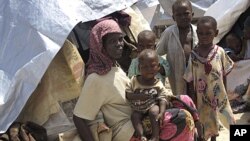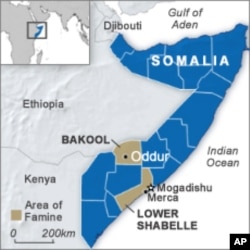A senior official of the World Health Organization says five more regions in southern Somalia are on the brink of famine. In a telephone briefing from Nairobi, WHO’s Representative for Somalia tells journalists in Geneva conditions for millions of people in the country affected by drought and violence are continuing to deteriorate.
WHO representative for Somalia, Marthe Everard, paints a very grim picture of Somalia where 3.7 million people, nearly one-half of the population, is in need of humanitarian assistance.
She says up to 50 percent of children in southern regions of Somalia are malnourished. And, adults too are malnourished because of lack of food. She says bad nutrition leads to bad health. She says there is a remarkable increase in measles and waterborne diseases also are on the rise.
WHO has recorded more than 50,000 cases of acute watery diarrhea and cholera since January. Everard says there is no breakdown as to the number of cholera cases. But, adds the disease is under control. She says there is no cholera epidemic because WHO has set up a good monitoring system.
|
Definition of Famine: The word famine is a term that is not used lightly by humanitarian organizations. The United Nations describes a crisis as a famine only when the following conditions are met:
Current Famine:
|
Two days ago, the United Nations declared two regions in southern Somalia as suffering from famine. Everard says a third region also is affected and famine appears to be spreading to other regions as well.
“We have declared only three regions in south Somalia. But, the five others are on the brink of also being seen as a famine. So, these areas indeed appear to be coming to a full-blown famine if we are not responding from now on to this enormous crisis,” she said.
The International Committee of the Red Cross is one of the few international organizations working in southern Somalia. The agency says Somalia’s appalling humanitarian crisis has reached a new low point. It notes more and more Somali people are leaving their country because their suffering has become unbearable.
ICRC spokeswoman, Nicole Engelbrecht, says conditions for the hundreds of thousands of internally displaced people are particularly bad. She says there has been a dramatic deterioration in their condition.
She attributes much of this to the serious toll the drought is having on livestock. She says livestock are severely affected by the lack of pasture and water, especially in the southern and central regions.
“We have also seen that many animals, especially cattle have died. And, this puts a difficult strain on the pastoralist families because the few animals that are still there are often too weak to give any milk. That is actually one of the reasons why malnutrition rates have gone up, especially among children because this has a strongly negative impact on the nutrition of children who do not have access to this milk,” said Engelbrecht.
The U.N. Children’s Fund estimates nearly 780,000 children under five in Somalia alone are malnourished and at risk of death without urgent assistance. In total, it finds almost two and one quarter million children in Ethiopia, Kenya and Somalia are estimated to be acutely malnourished.
U.N. aid agencies have been asking the al-Qaida linked al-Shabab militant group for guarantees of safety so they can access southern Somalia and provide the millions of famine victims with assistance.
Hopes for such guarantees appear to be dimming. The rebel group recently denied the existence of famine in Somalia, calling U.N. reports of famine “sheer propaganda.” U.N. aid agencies say the skeletal bodies of the Somali people, rising malnutrition rates and increasing number of deaths speak for themselves.
















